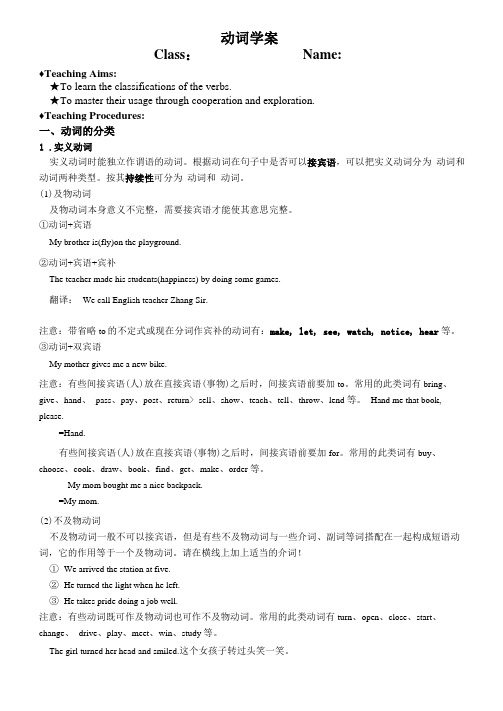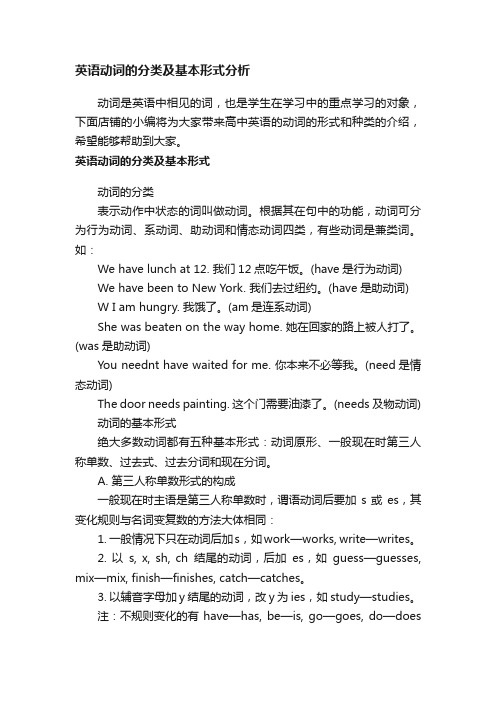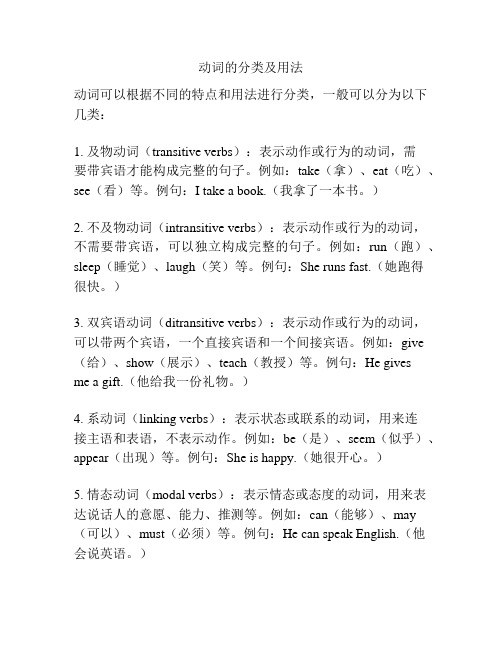动词的形式和分类
英文中动词的分类和用法

英文中动词的分类和用法在英语学习中,动词是至关重要的一部分。
动词不仅能够表达动作、状态和行为,还在句子结构和语法规则中起着关键作用。
为了更好地理解和运用英语,我们有必要深入了解英文中动词的分类和用法。
一、动词的分类1、实义动词(Notional Verb)实义动词是表示具体动作或状态的动词,能够独立地充当谓语。
例如:run(跑)、jump(跳)、eat(吃)、sleep(睡觉)、think(思考)等。
实义动词又可以分为及物动词(Transitive Verb)和不及物动词(Intransitive Verb)。
及物动词:后面需要接宾语才能表达完整的意思。
比如,“I love you”中的“love”就是及物动词,“you”是宾语。
不及物动词:自身就能表达完整的意思,不需要宾语。
例如,“The bird flies”中的“flies”就是不及物动词。
2、系动词(Linking Verb)系动词用于连接主语和表语,说明主语的性质、状态、特征等。
常见的系动词有:be(am/is/are/was/were)、seem(似乎)、look(看起来)、sound(听起来)、feel(感觉)、taste(尝起来)、smell(闻起来)等。
例如,“She is beautiful” 中的“is”就是系动词,“beautiful”是表语。
3、助动词(Auxiliary Verb)助动词主要用于协助主要动词构成各种时态、语态、语气等。
常见的助动词有:do/does/did、have/has/had、will/would、shall/should、be (am/is/are/was/were/been/being)等。
例如,“He is doing his homework” 中的“is”就是助动词,“doing”是主要动词。
4、情态动词(Modal Verb)情态动词表示说话人的态度、情感或推测等。
常见的情态动词有:can/could、may/might、must、shall/should、will/would、ought to、need、dare等。
动词的分类及基本形式

动词的分类及基本形式表示动作和状态的词叫做动词。
1)根据其在句中的功能,动词可分为四类,分别是:实义动词(Notional Verb)、系动词(Link Verb)、助动词(Auxiliary Verb)、情态动词(Modal Verb)。
还可以分成及物动词和不及物动词说明:有些情况下,有些动词是兼类词,例如:We are having a meeting. 我们正在开会。
(having是实义动词。
)He has gone to New York. 他已去纽约。
(has是助动词。
)2)动词根据其后是否带有宾语分为两类,分别是:及物动词(Transitive Verb)、不及物动词(Intransitive Verb),缩写形式分别为vt. 和vi.。
说明:同一动词有时可用作及物动词,有时可用作不及物动词。
例如:She can dance and sing. 她能唱歌又能跳舞。
(sing在此用作不及物动词。
)She can sing many English songs. 她能唱好多首英文歌曲。
(sing用作及物动词。
)3)根据是否受主语的人称和数的限制分别是:限定动词(Finite Verb)、非限定动词(Non-finite Verb)例如:She sings very well. 她唱得很好。
(sing受主语she的限制,故用第三人称单数形式sings。
)She wants to learn English well. 她想学好英语。
(to learn不受主语she的限制,没有词形变化,是非限定动词。
说明:英语中共有三种非限定动词,分别是:动词不定式(Infinitive)、动名词(Gerund)、分词(Participle)。
4)根据动词的组成形式,可分为三类,分别是:单字词(One-Word Verb)、短语动词(Phrasal Verb)、动词短语(Verbal Phrase)例如:The English language contains many phrasal verbs and verbal phrases. 英语里有许多短语动词和动词短语。
动词的基本形式及常用分类

动词的基本形式英语动词有五种基本形式,即动词原形、第三人称单数(现在式)、过去式、过去分词和现在分词。
1. 第三人称单数的构成方法与名词的单数变复数规则大致一样,即:(1)一般情况下由动词后加-s构成:work / works,read / reads等。
(2)以s, x, z, sh, ch 以及字母o结构的动词,后加-es:guess / guesses, mix / mixes, go / goes, buzz / buzzes, finish / finishes, catch / catches等。
(3)以辅音字母加y结尾的动词,应将y改为i 再加-es:fly / flies, study / studies等。
【注】①有个别的变化不规则,如have / has, be / is等。
②词尾-s和-es 读音规则是:在s, x, z, sh, ch 后的es读作[iz],其余的读作[z]。
2. 过去式和过去分词的构成方法分规则变化和不规则变化两种。
不规则变化需逐个记忆,规则变化遵循以下原则:(1)一般情况下,在动词后加ed构成:work / worked, stay / stayed, shout / shouted等。
(2)在以-e结尾动词后只加d:close / closed, like / liked, live / lived, smile / smiled等。
(3)以辅音字母加y结尾的动词,应将y改为i 再加-ed:study / studied, carry / carried等。
(4)以重读闭音节或r音节结尾且末尾只有一个辅音字母动词,要双写末尾的辅音字母再加-ed:stop / stopped, admit / admitted, refer / referred, prefer / preferred等。
【注】(1)以字母l结尾的动词,若末尾一个音节为重读音节,则必须双写l再加-ed,如control / controlled,但若末尾一个音节为非重读音节,则可双写l(英国英语)或不双写l(美国英语),如travel / travel(l)ed。
动词的分类和形式

动词的分类和形式动词的分类考点一实义动词1、定义及分类实义动词是能独立作谓语的动词。
根据动词在句子中是否可以接宾语,可以把实义动词分为及物动词和不及物动词。
按其持续性可分为延续性动词和非延续性动词。
(1)及物动词及物动词本身意义不完整,需要接宾语才能使其意思完整。
①动词+宾语,如:My brother is flying the kite on the playground.我弟弟在操场上放风筝。
②动词+宾语+宾补,如:The teacher made his students happy by doing some games.老师通过做一些游戏让学生们很开心。
We call the bird Polly.我们叫这只鸟Polly。
[注意]带省略to的不定式或现在分词作宾补的动词有:make, let, see, watch, notice, hear 等。
③动词+双宾语,如:My mother gives me a new bike.我妈妈给我一辆新自行车。
[注意]有些双宾语动词间接宾语(人)放在直接宾语(事物)后时,间接宾语前要加to。
常用的此类词有:bring、give、hand、 pass、pay、post、return、sell、show、teach、tell、throw、lend等。
如:Hand me that book, please. = Hand that book to me, please.请把那本书递给我。
有些双宾语动词间接宾语(人)放在直接宾语(事物)后时,间接宾语前要加for。
常用的此类词有buy、choose、cook、draw、book、find、get、make、order等。
如:My mom bought me a nice backpack. = My mom bought a nice backpack for me.我妈妈给我买了一个很好的背包。
(2)不及物动词不及物动词一般不可以接宾语,但是有些不及物动词与一些介词、副词等词搭配在一起构成短语动词,它的作用等于一个及物动词。
动词的种类、形式及辨析-小学英语总复习

【典题答案】 4.B。考查近义动词辨析。题意“——苏,你完成作业了
吗?”“——完成了,我花费了一个小时做作业。” spend 花费,spend… (in) doing sth.意为“做某事花费……” 或spend… on sth.意为“花费……在某件事上”; take 花费,主语为后面的不定式,符合句型It+takes +sb.+时间+to do sth.意为“做某事花费某人多长时间”; cost 花费,主语是物;pay 花费,主语是人,短语 pay… for… 意为“支付……。”分析句子可知此处 It代替后面的动词不定式to do it,故选B。
9
( )5.(2019·贺州第36题)The fruit salad________
delicious. I'd like to have more.
A.tastes
B.touches
C.sounds
D.feels
【典题答案】
5.A。考查动词词义辨析。题意“水果沙拉________美味。我
想再吃点。”taste 尝起来;touch 触摸;sound 听起来;feel感
其余选项均与“说”有关,say后接说话的内容,speak后接
语言,talk不及物动词,后跟介词,均不符合语境,所以选C。
6
( )3.(2019·北部湾经济区第38题)—Must I hand
in the homework right now?—______ That's the rule.
A.Yes,you can.
24
情态 动词
用法
例句
1.表示能力,意为 Mike can run fast.迈克能
can
“能、会”
动词地各种形式和分类

动词的各种形式和分类复习要点阐述动词的语法现象较为复杂,难度较大,是中考中重点考查的知识之一,了解动词的各种形式以及动词的分类,特别是注意动词的语法意义,不同的词形和固定搭配用法是非常重要的,可以说英语是由许许多多的搭配用法而组成的。
今天我们这个专题中将复习动词的各种形式和分类。
通过这种复习,使同学们明白在初中阶段动词的用法的原因。
我们主要复习归纳以下的内容:1.动词的各种形式;2.动词的种类(1)实义动词(2)联系动词(3)情态动词和助动词3.动词短语一、动词的各种形式英语动词有五种基本形式,即动词原形、一般现在时第三人称单数、过去式、过去分词和现在分词。
规则动词的五种形式如下表所示(以动词walk,like,stop,play为例):原形第三人称单数过去式过去分词现在分词walk walks walked walked walkinglike likes liked liked likingstop stops stopped stopped stoppingplay plays played played playing1.一般现在时第三人称单数的构成动词的一般现在时第三人称单数的构成如下表所示:2.规则动词过去式、过去分词的构成规则动词过去式、过去分词的构成如下表所示:特别提示:travel的过去式和过去分词英国写法为travelled,travelled,而美国写法为traveled,traveled。
在英语中这样的动词还有quarrel等。
发音规则:动词第三人称单数的发音规律与名词的复数形式发音规律是一致的。
动词的过去式和过去分词发音规律为:文档大全③现在分词的构成现在分词的构成如下表所示:常用必背:在变为现在分词时须双写最后一个字母的常用动词有:begin 开始cut 切割dig 挖drop 掉forget 忘记get 使、得到hit 击中let 让prefer 更喜欢put 放run 跑sit 坐shop 买东西stop 停止swim 游泳refer 参考以辅音字母+y结尾的动词,去掉y加-ies变为第三人称单数形式,加-ied变为过去式和过去分词的常用动词有:carry携带copy抄cry哭fry油煎hurry快走spy侦探study学习try试tidy整理worry担忧二、动词的种类根据不同的分类方式,动词可分为不同的类型。
动词的种类和基本形式

2.连系动词(linking verb[缩]vi.)连系动词用于连接主语和表语,说明主语的状态、性质特征或身份 等: He is a student.他是个学生。 常见的连系动词的分类[参见look]。 有些动词既是实义动词又是连系动词: Look at the blackboard.[vi.实义动词]看黑板。 He looks tired.[vi.连系动词]他看起来很累。 3.助动词(auxiliary verb[缩]aux.v.)助动词一般无实际意义,只是帮助构成谓语,表示时态、语态、语气等, 或构成疑问式及否定式。英语的助动词有be (am,is,are,was,were,been,being);have(have(has, had);do(does,did);shall(should);will(would)。 (1)助动词be用于构成进行时态和被动语态,或和动词不定式一起构成复合谓语表示根据安排将要发生的事, 应该做的事以及可能要做的事等: We are having a meeting now.我们现在正在开会。 The book was written by Lu Xun.这本书是鲁迅写 的。 Where are we to meet?我们在哪里碰头? (2)助动词have用于构成完成时态: I have studied English for six years.我已学了6年英语了。
动词的种类 和基本形式
动词是表示动作或状态的词。英语动词具有时态、语态、语气和人称、数等变化。 一、动词的种类 从是否被主语限定看,动词可分为谓语动词和非 谓语动词(含:不定式、动名词、现在分词,过去分词)[参见语法"非谓语动词"]两种。从含义上看,可 分为实义动词、连系动词、助动词和情态动词四类。 1.实义动词(notional verb)实义动词是能独立作谓语的动词。根据其句法作用分为及物动词和不及物动词。 (1)及物动词(transitive verb[缩]vt.)及物动词本身意思不完整,需要接宾语才能使其意思完整: We study English.我们学习英语。 (2)不及物动词(intransitive verb[缩]vi.)不及物动词自身意思完整,无须接宾语: The sun rises in the east.太阳从东方升起。 有一部分实义动词既可作及物动词又可作不及物动词: The fly spreads disease.[vt.]苍蝇传播疾病。 The news spreads quickly.[vi.]消息传得很快。 有些动词在英语中是及物的,但在汉语中是不及物的或者相反: Do you agree to the plan?[agree是vi.]你同意这个计划吗? We should serve the people.[serve是 ut.]我们应该为人民服务。
动词的分类及形态

1、形容词、形容动词做定语1)日语形容词可以直接修饰名词是作定语,形容词修饰名词时的形态叫【连体形】,形容词的连体形和终止形相同。
高い建物おいしい物重い荷物安い物苦しい生活楽しい一日2)形容动词作定语时,【だ】变成【な】,这种形态叫形容动词的【连体形】。
上手な日本語便利な所得意な料理綺麗な花親切な人有名な絵2、动词作谓语1)、動詞の分類动词分词干和词尾两部分。
例如働く、読む动词往往是在词尾发生变化,这种变化叫动词的活用。
动词的变化形态被分为四大类:1、五段动词2、一段动词(上一段「い段」、下一段「え段」)3、サ変動詞(する)4、カ変動詞(来る)动词在句子中根据用法和后续词发生变化,这种变化形态叫活用形。
包括以下六种形态。
1、未然形(否定形式)行く行かないするしない2、连用形(ます形)行きます食べますしますきます3、终止形(原形,用于简体句的终了。
还可以接部分助词如「と、か、ね、でしょう」)。
私は本を読む4、连体形(和终止形形态完全相同,后接体言是则为连体形)例如;あれは公園へ行くバスです。
教える先生5、假定形(行けば、食べれば、すれば、これば)6、命令性(五段エ段一段るろするしろ)动词的变化形态被分为四大类:1、五段动词2、一段动词(上一段「い段」、下一段「え段」)3、サ変動詞(する)4、カ変動詞(来る)词干连用形サ変:するすし(ます)カ変:来るきき(ます)如何判断一段动词;①、首先要看动词的词尾是【る】的形式。
②、再看【る】前面的假名是不是在【い】段、【え】段里。
起きる、食べる、降りる、見る、染める一段动词以外的其余的全是五段动词。
書く、泊る、注意:在五段动词的里面,也有数量很少的特殊的五段动词它看起来像一段动词但是不是。
这几个少量的特殊的五段动词需要特别记。
入る(はいる)、帰る(かえる)、滑る(すべる)3)、自动词和他动词动词从及物和不及物角度分为自动词和他动词自动词:表现自身的动作、作用而不需要宾语即不涉及其他对象的动词叫做自动词。
浅谈现代汉语动词的分类

现代汉语动词是汉语语法系统中的重要组成部分,它们表达的是动作、状态和经历等概念。
根据动词的不同特征,可以将它们分为许多类别。
一、按词义分类
1、行为动词:表示动作的动词,如“说”、“做”、“看”等。
2、状态动词:表示状态的动词,如“有”、“喜欢”、“知道”等。
3、经历动词:表示经历的动词,如“遇见”、“听见”、“想起”等。
二、按词性分类
1、实义动词:表示实际意义的动词,如“走”、“唱”、“写”等。
2、虚义动词:表示抽象意义的动词,如“想”、“应该”、“可以”等。
三、按动词形式分类
1、单音节动词:只有一个音节的动词,如“走”、“唱”、“写”等。
2、双音节动词:有两个音节的动词,如“吃饭”、“看书”、“做事”等。
3、多音节动词:有三个或三个以上音节的动词,如“发现”、“改变”、“参加会议”等。
四、按动词语态分类
1、被动语态:表示被动的动词,如“被吃”、“被看”、“被写”等。
2、主动语态:表示主动的动词,如“吃”、“看”、“写”等。
以上就是现代汉语动词的分类,它们在汉语语法系统中扮演着重要的角色,是汉语语言的重要组成部分。
概说动词分类形式

2)及物动词(transitive verb)和不及物动 词(intransitive verb)和系动词(link verb) 根据动词能否有宾语,可以将动词分为 及物动词和不及物动词和系动词。 及物动词是指动词所表达的动作能有一 个接受动作的对象,也就是 后面可以接宾语 的动词。及物动词可以分为单及物动词 (mono-transitive verb)和双及物动词 (di-transitive verb)以及复合及物动词 (complex-transitive verb)
(四)不定式和-ing分词 英语动词的不定式分为带to不 定式(如:I like to play football.) 和不带to不定式(如:I can drive)。[有很多语法书都说,情 态助动词后面跟的是动词原形,这 个提法不够严谨。]-Ing分词是由主 动词的原形加ing构成。
现在分词的构成
(三)过去时和-ed分词 英语主动词的过去时和-ed分词分 为规则形式和不规则形式。规则 动词是由原形加ed的方式构成过 去时和-ed分词。不规则动词可参 考各英语词典附录里的不规则动 词表。
过去式和过去分词的构成
1.一般情况直接加ed,如ask—asked, work— worked。 2. ance—danced。 3. 以辅音字母加y结尾,把y变为ied,如try— tried, study—studied。 4. 以一个元音字母和一个辅音结尾的重读音节 结尾的动词,先双末尾一个字母,再加ed, 如stop—stopped, permit—permitted。
非延续性动词可用于现在完成时态,但由于 动作是瞬时间完成的所以不能与for或since引 出的时间状语连用. 英语中常见的非延续性动词在完成时态中 可改为相应的表示延续性的动词或短语,这时 可与表示一段时间的的状语连用. 误:He has joined the Party for two years. 正:He has been a Party member for two years. 误:I have bought this computer for a month. 正: I have had this computer for a month.
动词的基本概念

动词的基本概念动词是语言中的一大类词性,用于表示人、事物或概念的动作、状态、变化等。
它是句子中最重要的成分之一,承担着表达和描述事件、行为以及时间关系的重要任务。
在本文中,我们将介绍动词的基本概念,包括动词的定义、分类、时态和语态等方面内容。
一、动词的定义动词是表示行为、状态或变化的词类。
它可以用来描述人或物的动作、情感、思维、感官等,同时也能够表示某种状态或存在的变化。
动词在句子中通常具有谓语的功能,用于构成句子的谓语部分。
二、动词的分类根据动词的特征和功能,可以将动词分为以下几类。
1.行为动词:表示人或事物进行的具体动作,如“跑、吃、读”。
2.状态动词:表示人或事物所处的状态,如“是、在、有”。
3.瞬间动词:表示短暂的动作或变化,如“打喷嚏、叹息”。
4.延续性动词:表示持续的动作或状态,如“写、工作”。
5.及物动词:需要有宾语才能完整表达意义的动词,如“看、打电话”。
6.不及物动词:无需宾语即可完整表达意义的动词,如“睡、笑”。
三、动词的时态和语态动词的时态用来表示动作或状态的发生时间,语态用来表示动作的主体和客体在句子中的关系。
1.时态:常见的动词时态包括过去时、现在时和将来时。
过去时表示过去发生的动作或状态,现在时表示现在正在进行或经常发生的动作或状态,将来时表示将要发生的动作或状态。
2.语态:动词的语态包括主动语态和被动语态。
主动语态表示主语执行动作,强调主语的作用,而被动语态表示主语接受动作,强调动作的承受者。
四、动词的词形变化动词的词形变化通常包括人称、数和时态的变化。
1.人称和数:动词根据句子的主语进行人称和数的变化。
主要的变化形式包括第一人称单数、第二人称单数、第三人称单数和复数形式。
2.时态:动词根据句子的时态进行时态的变化。
常见的时态变化形式包括过去式、现在分词和过去分词。
五、动词的辨析在使用动词时,有时需要根据上下文的语境进行动词的正确选择。
例如,表示某种动作的动词是否应该使用及物动词还是不及物动词,需要根据动作的具体情况来区分。
动词的形式和分类

Class :♦Teaching Aims: ★To learn the classifications of the verbs.★To master their usage through cooperation and exploration.♦Teaching Procedures:一、动词的分类1 .实义动词实义动词时能独立作谓语的动词。
根据动词在句子中是否可以接宾语,可以把实义动词分为 动词和 动词两种类型。
按其持续性可分为 动词和 动词。
(1)及物动词及物动词本身意义不完整,需要接宾语才能使其意思完整。
①动词+宾语My brother is(fly)on the playground.②动词+宾语+宾补The teacher made his students(happiness) by doing some games.翻译: We call English teacher Zhang Sir.注意:带省略to 的不定式或现在分词作宾补的动词有:make, let, see, watch, notice, hear 等。
③动词+双宾语My mother gives me a new bike.注意:有些间接宾语(人)放在直接宾语(事物)之后时,间接宾语前要加to 。
常用的此类词有bring 、 give 、hand 、 pass 、pay 、post 、return > sell 、show 、teach 、tell 、throw 、lend 等。
Hand me that book, please.=Hand.有些间接宾语(人)放在直接宾语(事物)之后时,间接宾语前要加for 。
常用的此类词有buy 、 choose 、cook 、draw 、book 、find 、get 、make 、order 等。
My mom bought me a nice backpack.=My mom.(2)不及物动词不及物动词一般不可以接宾语,但是有些不及物动词与一些介词、副词等词搭配在一起构成短语动 词,它的作用等于一个及物动词。
动词的分类和五种基本形式

2)英语中有些动词常常是既作及物动词又作不及物动词;既
作连系动词工作及物动词。
例如: He speaks English very well. (vt.)
整理ppt
2
He spoke at the meeting. (vi.)
动词
整理ppt
3
动词的另一种分类
另外,动词按其在句中能否作谓语,又可 分为两大类: ❖谓语动词(finite verb) ❖非谓语动词(non-finite verb)
2)词尾-es或-s在[s ]、[z]、[t ]、[d ]后面读[iz];在清辅音 后读[s];在浊辅音及元音后读[z];在[t],[d]后读[ts]、[dz]。
3)不规则动词的过去式与过去分词则要根据不规则动词 表逐渐记住。
整理ppt
7
IF引导的虚拟语气
整理pptபைடு நூலகம்
8
If虚拟语气
此课件下载可自行编辑修改,此课件供参考! 部分内容来源于网络,如有侵权请与我联系删除!感谢你的观看!
2)词尾-es或-s在[s ]、[z]、[t ]、[d ]后面读[iz];在清辅音后 读[s];在浊辅音及元音后读[z];在[t],[d]后读[ts]、[dz]。
3)不规则动词的过去式与过去分词则要根据不规则动词表 逐渐记住。
整理ppt
5
动词的五种基本形式
整理ppt
6
说明:
1)词尾-ed在清辅音后读[t];在浊辅音和元音后读[d];在 [t]和[d]后读[id]。
动词的分类和基本形式
整理ppt
1
动词的种类
动词按其词义和在句中的作用可以分为: 行为动词(或称实义动词)、 连系动词 助动词 情态动词。
动词的分类及用法总结

动词的分类及用法总结动词是语言中最重要的词类之一,它用来表示动作、状态或者发生的情况。
根据其用法和特点,动词可以分为不同的分类。
本文将对动词的分类及其用法进行总结,以帮助读者更好地理解和正确使用动词。
一、实义动词实义动词是指具有具体含义的动词,它们用来描述人或物的动作或状态。
实义动词可以进一步分为以下几种类型:1. 及物动词:及物动词是指需要带宾语才能构成完整意义的动词。
例如:"eat"(吃)、"write"(写)、"watch"(观看)等。
及物动词的宾语可以是名词或代词。
2. 不及物动词:不及物动词是指不需要带宾语就能构成完整意义的动词。
例如:"run"(跑)、"sleep"(睡觉)、"cry"(哭)等。
不及物动词通常用于表示主语的动作或状态。
3. 及物不定式动词:在句子中作为宾语补足语的动词,通常用不定式形式表示。
例如:"want to eat"(想要吃)、"like to play"(喜欢玩)等。
4. 自由及物动词:这类动词既可以作及物动词使用,也可以作不及物动词使用,根据上下文的变化而变化。
例如:"open"(开启)可以是及物动词("open the door",开门)也可以是不及物动词("the door opens",门开了)。
二、系动词系动词是用来连接主语和表语的动词,它们没有实际的动作含义,主要用于描述主语的状态、特征或性质。
常见的系动词有:"be"(是)、"seem"(似乎)、"appear"(显得)等。
系动词的用法多样,可以与形容词连用,表示主语的特征或性质,如:"She is beautiful"(她很漂亮);也可以与名词连用,表示主语的身份或职业,如:"He is a doctor"(他是一名医生)。
英语动词的分类及基本形式分析

英语动词的分类及基本形式分析动词是英语中相见的词,也是学生在学习中的重点学习的对象,下面店铺的小编将为大家带来高中英语的动词的形式和种类的介绍,希望能够帮助到大家。
英语动词的分类及基本形式动词的分类表示动作中状态的词叫做动词。
根据其在句中的功能,动词可分为行为动词、系动词、助动词和情态动词四类,有些动词是兼类词。
如:We have lunch at 12. 我们12点吃午饭。
(have是行为动词)We have been to New York. 我们去过纽约。
(have是助动词) W I am hungry. 我饿了。
(am是连系动词)She was beaten on the way home. 她在回家的路上被人打了。
(was是助动词)You neednt have waited for me. 你本来不必等我。
(need是情态动词)The door needs painting. 这个门需要油漆了。
(needs及物动词) 动词的基本形式绝大多数动词都有五种基本形式:动词原形、一般现在时第三人称单数、过去式、过去分词和现在分词。
A. 第三人称单数形式的构成一般现在时主语是第三人称单数时,谓语动词后要加s或es,其变化规则与名词变复数的方法大体相同:1. 一般情况下只在动词后加s,如work—works, write—writes。
2. 以s, x, sh, ch结尾的动词,后加es,如guess—guesses, mix—mix, finish—finishes, catch—catches。
3. 以辅音字母加y结尾的动词,改y为ies,如study—studies。
注:不规则变化的有have—has, be—is, go—goes, do—does等。
B. 现在分词的构成1. 一般情况下在动词后加ing,如study—studying, work—working。
2. 以不发音的字母e结尾的动词,先去掉e再加ing,如write—writing, move—moving。
动词的分类和五种基本形式

动词的分类和五种基本形式动词根据其用途和形式可以分为五种类别,分别是:1. 实义动词(lexical verbs):表示具体的动作、状态或变化,如run, eat, sleep。
2. 系动词(copular verbs):用来连接主语和表语,表示主语的性质、状态或特征,如be, seem, appear。
3. 助动词(auxiliary verbs):用来帮助构成时态、语态、语气或否定形式,如have, do, will。
4. 情态动词(modal verbs):表示说话人的态度、情绪、推测或可能性,如can, could, may。
5. 不及物动词(intransitive verbs)和及物动词(transitive verbs):不及物动词只需要一个主语,而及物动词需要一个主语和一个宾语。
五种基本形式是:1. 基本形式(base form):即动词原形,表示动作的基本概念,如study, walk, talk。
2. 现在分词形式(present participle):在进行时态中使用,表示正在进行的动作,一般以-ing结尾,如studying, walking, talking。
3. 过去分词形式(past participle):在完成时态和被动语态中使用,一般以-ed、-en、-t等结尾,如studied, walked, talked。
4. 第三人称单数形式(third person singular form):主语为第三人称单数时动词形式的变化,一般在一般现在时和一般过去时使用,如studies, walks, talks。
5. 动词的时态和语态形式(tense and voice forms):包括一般现在时、一般过去时、一般将来时、完成时、进行时、完成进行时等各种形式。
动词的分类及用法

动词的分类及用法动词可以根据不同的特点和用法进行分类,一般可以分为以下几类:1. 及物动词(transitive verbs):表示动作或行为的动词,需要带宾语才能构成完整的句子。
例如:take(拿)、eat(吃)、see(看)等。
例句:I take a book.(我拿了一本书。
)2. 不及物动词(intransitive verbs):表示动作或行为的动词,不需要带宾语,可以独立构成完整的句子。
例如:run(跑)、sleep(睡觉)、laugh(笑)等。
例句:She runs fast.(她跑得很快。
)3. 双宾语动词(ditransitive verbs):表示动作或行为的动词,可以带两个宾语,一个直接宾语和一个间接宾语。
例如:give (给)、show(展示)、teach(教授)等。
例句:He givesme a gift.(他给我一份礼物。
)4. 系动词(linking verbs):表示状态或联系的动词,用来连接主语和表语,不表示动作。
例如:be(是)、seem(似乎)、appear(出现)等。
例句:She is happy.(她很开心。
)5. 情态动词(modal verbs):表示情态或态度的动词,用来表达说话人的意愿、能力、推测等。
例如:can(能够)、may (可以)、must(必须)等。
例句:He can speak English.(他会说英语。
)6. 不定式动词(infinitive verbs):以to开头的动词形式,可以做动词的主语、宾语、表语等。
例如:to go(去)、to eat (吃)等。
例句:To study is important.(学习很重要。
)这些分类只是一种常见的方式,实际上动词的分类还有其他细分。
需要根据具体语境和用法来判断动词的分类和使用方法。
英语单词词性分类:将动作归类

英语单词词性分类:将动作归类一. 动词(Verb)动词是描述动作或状态的词汇。
它们用来表达一个人、物或事情所做的动作或所处的状态。
下面是一些常见的动词分类:1. 行为动词(Action Verbs):描述具体的动作或行为,例如:run(跑)、dance(跳舞)、eat(吃)等。
2. 状态动词(State Verbs):描述存在状态或条件的动作,一般不表示具体的动作,例如:be(是)、seem(似乎)、like(喜欢)等。
3. 情态动词(Modal Verbs):表示可能性、能力、意愿等,例如:can(能)、may(可能)、must(必须)等。
二. 动名词(Gerund)动名词是以-ing结尾的动词形式,可以作为名词使用。
它们表示一种具体的动作或状态。
例如:swimming(游泳)、running(跑步)、reading(阅读)等。
三. 分词(Participle)分词是动词的一种形式,用来表示动作进行中或已经完成。
常见的分词形式有:1. 现在分词(Present Participle):以-ing结尾,用于表示进行中的动作或状态,例如:running(正在跑)、swimming(正在游泳)等。
2. 过去分词(Past Participle):常以-ed、-en、-t等形式结尾,用于表示已完成的动作或状态,例如:written(已写)、broken (已破碎)等。
四. 不定式(Infinitive)不定式是动词的一种形式,一般以to加上动词原形构成。
不定式可以作为名词、形容词或副词使用。
例如:to run(跑步)、to eat(吃饭)、to learn(研究)等。
以上是一些常见的英语动词词性分类及其说明。
希望对您有帮助!。
- 1、下载文档前请自行甄别文档内容的完整性,平台不提供额外的编辑、内容补充、找答案等附加服务。
- 2、"仅部分预览"的文档,不可在线预览部分如存在完整性等问题,可反馈申请退款(可完整预览的文档不适用该条件!)。
- 3、如文档侵犯您的权益,请联系客服反馈,我们会尽快为您处理(人工客服工作时间:9:00-18:30)。
动词学案Class:Name:◆Teaching Aims:★To learn the classifications of the verbs.★To master their usage through cooperation and exploration.◆Teaching Procedures:一、动词的分类1. 实义动词实义动词时能独立作谓语的动词。
根据动词在句子中是否可以接宾语,可以把实义动词分为__________动词和_________动词两种类型。
按其持续性可分为_____________动词和___________动词。
(1)及物动词及物动词本身意义不完整,需要接宾语才能使其意思完整。
①动词+宾语My brother is ________ ______ ________(fly)on the playground.②动词+宾语+宾补The teacher made his students___________(happiness) by doing some games.翻译:We call English teacher Zhang Sir.____________________________________________________注意:带省略to的不定式或现在分词作宾补的动词有:make, let, see, watch, notice, hear等。
③动词+双宾语My mother gives me a new bike.注意:有些间接宾语(人)放在直接宾语(事物)之后时,间接宾语前要加to。
常用的此类词有bring、give、hand、pass、pay、post、return、sell、show、teach、tell、throw、lend等。
Hand me that book, please.= Hand____________________________________.有些间接宾语(人)放在直接宾语(事物)之后时,间接宾语前要加for。
常用的此类词有buy、choose、cook、draw、book、find、get、make、order等。
My mom bought me a nice backpack.= My mom________________________________________.(2)不及物动词不及物动词一般不可以接宾语,但是有些不及物动词与一些介词、副词等词搭配在一起构成短语动词,它的作用等于一个及物动词。
请在横线上加上适当的介词!①We arrived______ the station at five.②He turned _______ the light when he left.③He takes pride_______ doing a job well.注意:有些动词既可作及物动词也可作不及物动词。
常用的此类动词有turn、open、close、start、change、drive、play、meet、win、study等。
The girl turned her head and smiled. 这个女孩子转过头笑一笑。
She turned and walked back to the classroom. 她转过身走回教室。
(3)延续性动词延续性动词表示动作是可持续的,如:live, stay, study, work, keep, teach等,可以和时间段连用。
We have lived in China since 2001.You can keep this book for two weeks.(4)非延续性动词非延续性动词表示瞬间动作,如:buy, lend, borrow, die, begin, stop, finish, arrive, join, leave, come, catch等,不能和时间段连用。
如果和时间段连用,就要用其他词代替。
He has been here for five days.(arrive)The film has been on for ten minutes.(begin)常用瞬间动词相应持续性动词关系如下:1、go——be away2、come——be here3、come back——be back4、leave——be away(be not here)5、buy——have6、borrow——keep7、die——be dead 8、begin——be on9、finish——be over 10、open——be open11、close——be closed 12、lose——be lost13、get to know——know 14、turn on——be on15、get up——be up 16、sit down——sit/be seated17、join——be in(…)或be a…member18、become——be2. 连系动词连系动词也称为系动词,连系动词有一定词义,但不完整,不能单独做谓语,必须和表语连用,构成系表结构,表示主语身份、性质、状态。
You are a teacher, but not a good one.We feel very happy when we know it.英语经常用到的连系动词有:(1) 状态连系动词:表示主语的状态、性质、身份。
(be)My father is very strong.(2) 持续连系动词:表示继续或保持一种状态或情况。
(stay,remain,keep等)You must keep healthy.(3) 表象连系动词:用来表示“看起来”的这一概念的词。
appear(看起来),seem(看似),look(看起来)。
Your mother looks much younger than I thought.(4) 感官连系动词:feel(摸起来),taste(尝起来),smell(闻起来),sound(听起来)look(看起来)。
The milk tastes a little sour.(5) 转变或结果连系动词:become(变为),get(成为),grow(长得),turn(变得),go(变得)等。
Our village is becoming more and more beautiful.3.助动词助动词本身没有词意,或者意义不完全,不能单独作谓语,只能和别的动词一起在句子中作谓语,帮助动词构成各种时态、语态等及否定、疑问、强调等。
主要的助动词有:be,do,have,shall,will 等。
例如:Will you have a sports meeting next week?Is your mother cooking?Don’t be late for class next time.4. 情态动词情态动词一般没有人称和数的变化,在句子中不能单独作谓语,只能和其他动词连用作谓语,表示说话人的语气和情感。
主要的情态动词有:can,may,must,need,would,could,might,dare等。
使用情态动词要注意以下方面:(1) 含must的一般疑问句,肯定回答仍用must,否定回答则用needn’t或don’t have to,表示“不必”。
一般不能用mustn’t,因为mustn’t表示“不可以、禁止”,语气很强。
—Must I finish my homework now?—No, you needn’t.(2) may开头的一般疑问句,肯定回答用may,否定回答用mustn’t。
—May I smoke here?—No, you mustn’t.(3) 表示可能性或推测时,can多用于否定句或疑问句,can’t表示“不可能”;may多用于陈述句,may not表示“可能不”;must只用于肯定句,表示“一定、准是”。
You may be right or may not be right.The news can’t be true.She must be angry.(4) need用作情态动词主要用于否定句、疑问句和条件句,表示“需要”,也可以作实义动词,后跟名词、代词、不定式、动词-ing形式等。
need开头的一般疑问句,肯定回答用must。
You needn’t come if you are busy.—Need I come tomorrow? 我明天需要来吗?—No, you needn’t. / Yes, you must. 不,没必要。
/ 是的,你必须来。
He needs to get some sleep. 他需要睡一会。
(5) have to的意思接近must,但是must强调说话者的主观意愿。
have to强调客观上的必要性,常译成“不得不“。
have to可以用于多种时态,其疑问句、否定句都要借助do构成。
Do you have to leave now? 你现在必须走了吗?You don’t have to get up early. 你没有必要早起。
(6) be able to表示具体的能力,与can用法相近,can只有一般现在时和一般过去时,be able to 可用更多的时态。
was / were able to侧重有能力而且成功地做成了某事,而could只表示过去具备某种能力。
The math problem was hard but I was able to work it out. 这道数学题很难,但我做出来了。
二、动词的形式1. 动词原形动词原形就是词典中出现的动词原来的形式。
例如:be (是),work(工作),study(学习),write (写)等。
动词原形用法很多,经常在中考考查的用法有:(1) 在一般现在时中主语不是第三人称单数形式,其谓语动词接动词原形。
例如:We often watch TV at home after supper.(2) 感官动词和使役动词后接动词原形作宾语补足语。
例如:Your words make me feel angry.(3) 在祈使句的开头用动词原形。
例如:Come and buy your books at our book shop.(4) 在情态动词和do、will、would等助动词后用动词原形。
例如:Can you swim across this river in an hour?Did everybody want to go there last Monday?(5) 常见的后面用动词原形的结构:Why not do sth.? = Why don’t you do sth.?had better do sth.Let sb. do sth.help sb. do sth.Why not go there on foot?You’d better finish your homework before supper.Let’s play volleyball after school!2. 第三人称单数形式动词的第三人称单数形式就是句子的主语是第三人称单数形式,并且谓语是一般现在时,谓语动词应该用第三人称单数形式。
